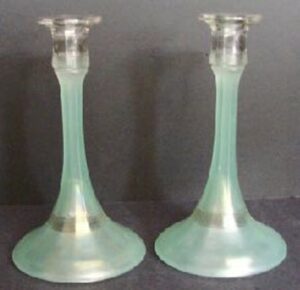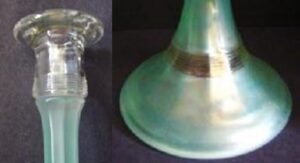Tavern-Flute and Rings Candlesticks
By Barb Chamberlain
The Duncan Miller company produced the Flute and Rings candlesticks. Not a lot is known about these candlesticks. The pattern was produced as their #83 pattern. The Duncan Glass Company began production in the mid-1800’s. In 1890 they joined the U.S. Glass Company, but when fire destroyed the company, Duncan Glass Company was released from the conglomerate and formed George Duncan’s new company in Washington, Pennsylvania. As an interesting sidelight, George Duncan’s son-in-law was Augustus Heisey, who, as most of you know, also produced glass with a few pieces that were iridized. I believe that this pattern was probably named by carnival glass collectors as Flute and Rings because there is a flute pattern on the interior of the base, the exterior of the column, and inside the cup. There are six thin rings on the base of the cup and also on the top portion of the domed base, both of which are on the exterior. Dave Doty shows a pair of lavender candlesticks on his website. They appear to be crystal with a lavender flashed iridescence. The pair sold in 2010 and a single in 2016. Carnival Glass 101 also includes these candlesticks in the lavender flashed color, perhaps the same ones as Doty shows. We recently were able to purchase a different set of these unusual candlesticks. Ours have a fired on green “enamel” from the bottom of the candle cup to the bottom of the candlesticks. The iridescence seemed to have been applied to the underside of the base and the top and inside of the candle cup. 
These are fairly stately candlesticks with a base diameter of about five inches and an overall height of nine inches.
Note the rings at the bottom of the candle cup and the top of the base. You may also see the flutes on the stick in the candle cup photo.
If you have a set of Flute and Rings candlesticks in one of these or other colors, please email me at dbcham@iowatelecom.net or 124 E. Honey Creek Dr., Manchester, IA 52057. Include a photo if possible. The members would enjoy seeing additional sets.
This article first appeared in the ICGA Pump in the December 2018 issue and is reprinted with permission.

